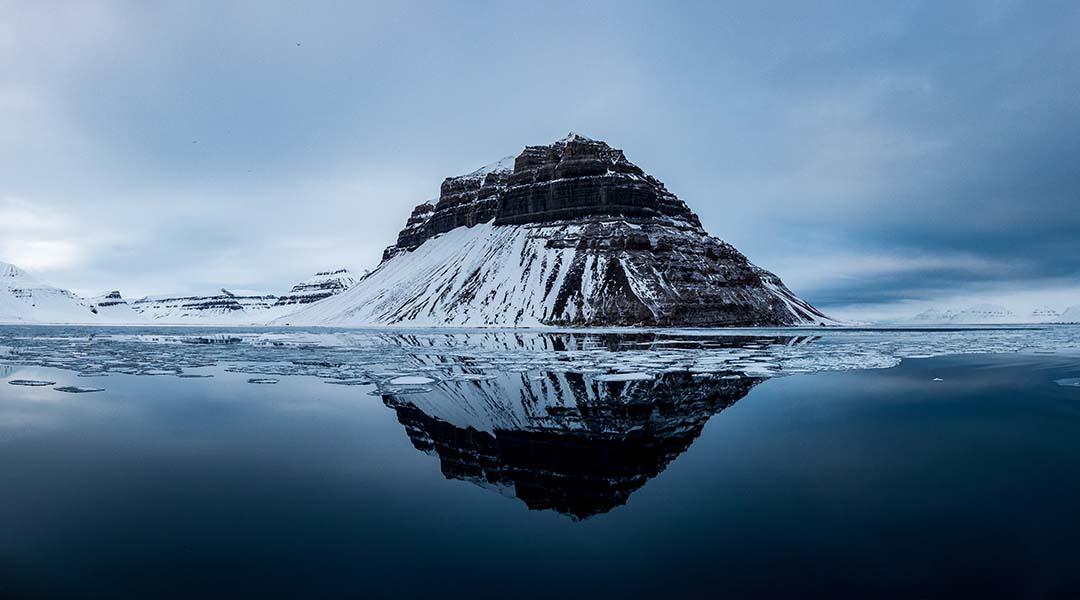Air temperatures across Svalbard, a Norwegian archipelago, are rising at twice the rate as in the rest of the Arctic. Compared to the rest of the world, the rate of increase is even worse—five to seven times higher. Since 1936, glaciers in Svalbard have lost 30% of their volume.
When glaciers melt, groundwater springs gush forth through the newly-exposed ground. Even during winter, groundwater springs leak out near the edge of glaciers. When groundwater is exposed to surface temperatures, it rapidly freezes. The resulting ice fields can stretch for kilometers, running several meters thick.
Beneath these glaciers and permafrost, lie colossal deposits of the harmful greenhouse gas, methane. Researchers believe that methane escape might be accelerating warming in this part of the world. To test this theory, Gabrielle Kleber, of the University of Cambridge, in the U.K., and colleagues explored the potential seepage of methane from groundwater springs near melting glaciers.
To collect samples of groundwater, Kleber and colleagues drilled deep into these fields of ice, until they hit the pressurized springs. “We were surprised to find just how much methane was present in these groundwater springs,” Kleber told Advanced Science News. “In fact, sometimes when we’d drill into the ice, we’d find that a lot of very pressurized gas was released before the water. This gas could be ignited, meaning that it was mostly methane.”
The team’s goal was to quickly capture and transport the samples back to a laboratory—all while keeping the water from freezing, even as surface temperatures dropped below negative 20℃. The researchers collected samples from 123 groundwater springs from 78 glaciers across central Svalbard. Zipping across the icy landscapes of the archipelago on snowmobiles, the research team could cover a lot more ground than simply traversing it on foot.
Back at the laboratory, they analyzed the water samples for both methane concentration and composition. In most cases, the groundwater springs were methane-rich, with concentrations more than 600,000 times higher than those found in air. Once methane reaches the surface of water, it dissipates into the atmosphere. “We estimate that these groundwaters on Svalbard could be releasing about 2,300 tonnes of methane per year,” said Kleber. By analyzing the composition of methane in their samples, the researchers found that it most likely had arisen from deep within the ground.
Glaciers can terminate on land or in water, depending on where their leading edge ends. Besides the 78 land-terminating glaciers that Kleber’s group analyzed, they also collected samples from fjord surface waters near 3 marine-terminating glaciers in central Svalbard. The methane in these waters was apparently from deep under the seafloor. Once again, methane levels were extremely high near these glaciers.
Since methane is easily broken down within large volumes of water before it can enter the air, these high concentrations are less concerning. “Microbes in the seawater are very effective at using oxygen in the water to consume the methane,” said Kleber. What’s especially worrying is climate change-driven glacial retreat has transformed more than 7% of the Arctic’s 1,704 marine-terminating glaciers to land-terminating glaciers over the last two decades. As more and more of these marine-terminating glaciers retreat, methane will find more escape routes into the environment.
Anthropogenic greenhouse gas emissions that cause global warming are melting glaciers. “We’ve found a feedback loop that has the potential to accelerate or exacerbate global warming,” said Kleber. As glaciers melt, methane emissions from groundwater sources are expected to rise. “We need to take control of and limit our emissions so that we curb the warming of our planet and prevent these knock-on emissions from getting out of hand,” added Kleber.
Warming in the Arctic is seemingly rising at a faster pace than models have predicted. Researchers suggest that feedback loops, like this one, likely are ignored by climate models. Methane-rich rocks found in Svalbard are also found in other parts of the Arctic, such as in Canada, Greenland and Russia.
“We believe that these emissions are probably prevalent throughout other regions of the Arctic, and thus could be a considerable source of methane to the Arctic atmosphere,” added Kleber.
Reference: Gabrielle E. Kleber, et al., Groundwater springs formed during glacial retreat are a large source of methane in the high Arctic, Nature Geoscience (2023). DOI: 10.1038/s41561-023-01210-6

















